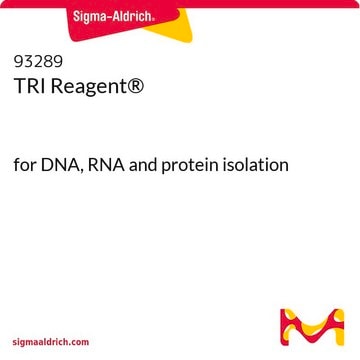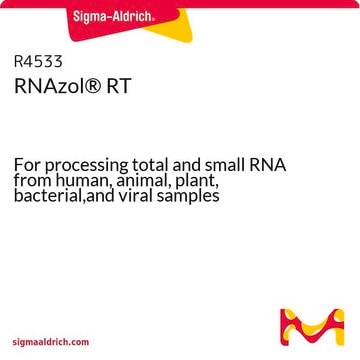B9673
1-Bromo-3-chloropropane
for isolation of RNA
Synonym(s):
1-Bromo-3-chloropropane, I-BCP, Trimethylene bromochloride, Trimethylene chlorobromide
About This Item
Recommended Products
grade
for molecular biology
Assay
≥98.5% (GC)
form
liquid
refractive index
n20/D 1.486 (lit.)
bp
144-145 °C (lit.)
density
1.592 g/mL at 25 °C (lit.)
storage temp.
room temp
SMILES string
ClCCCBr
InChI
1S/C3H6BrCl/c4-2-1-3-5/h1-3H2
InChI key
MFESCIUQSIBMSM-UHFFFAOYSA-N
Looking for similar products? Visit Product Comparison Guide
General description
Application
- feline teeth
- mice brain and liver tissues
- human ectocervical epithelial cells
- placental samples
- human mesenchymal stromal cells (hMSCs)
Features and Benefits
- less toxic alternative to chloroform
- compatible with TRI reagent for isolation of RNA with decreased DNA contamination
Other Notes
related product
Signal Word
Danger
Hazard Statements
Precautionary Statements
Hazard Classifications
Acute Tox. 3 Inhalation - Acute Tox. 4 Oral - Aquatic Chronic 3 - Muta. 2 - STOT SE 3
Target Organs
Respiratory system
Storage Class Code
6.1C - Combustible acute toxic Cat.3 / toxic compounds or compounds which causing chronic effects
WGK
WGK 2
Personal Protective Equipment
Certificates of Analysis (COA)
Search for Certificates of Analysis (COA) by entering the products Lot/Batch Number. Lot and Batch Numbers can be found on a product’s label following the words ‘Lot’ or ‘Batch’.
Already Own This Product?
Find documentation for the products that you have recently purchased in the Document Library.
Customers Also Viewed
Protocols
TRI Reagent enables simultaneous DNA, RNA, and protein isolation with sample prep guidelines and troubleshooting.
Method for purification, reverse transcription and quantitative PCR for MicroRNAs using Mysticq reagents
Our team of scientists has experience in all areas of research including Life Science, Material Science, Chemical Synthesis, Chromatography, Analytical and many others.
Contact Technical Service











